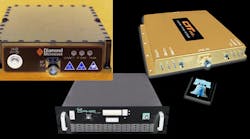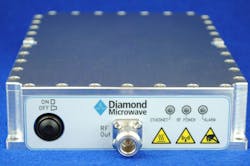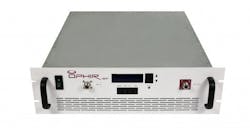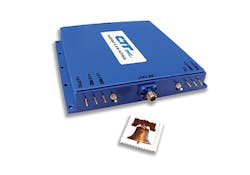Download this article in PDF format.
High-power amplifiers (HPAs) for RF/microwave applications were once automatically associated with electron-tube devices such as klystrons or traveling-wave tubes (TWTs). While those devices still provide some of the highest output-power levels available at microwave frequencies, solid-state HPAs are pushing output-power performance higher, largely due to the capabilities of gallium-nitride (GaN) wide-bandgap transistors that enable HPAs with high output-power levels in smaller packages.
The physical sizes of these amplifiers are generally limited by the thermal characteristics of the devices, their associated printed-circuit boards (PCBs), and their enclosures. Although GaN and other power transistors are also gaining in efficiency, even a device with 50% efficiency still wastes one-half of its supplied energy as heat and other forms of energy losses.
Amplifier output power comes in many forms. An amplifier designed for linear Class A or Class AB use (with transistors remaining turned on) with continuous-wave (CW) signals will generally deliver less output power than the peak power levels possible with an amplifier developed for pulsed signals. An example of the latter is a Class D amplifier that switches on and off to save power and boost efficiency. Solid-state RF/microwave amplifiers exploit several different transistor technologies, including silicon (Si) lateral diffused metal-oxide-semiconductor (LDMOS) devices for lower frequencies and GaN and GaAs field-effect transistors (FETs) at higher frequencies.
Some designs, such as the innovative model 2154-BB52E6ARR from Empower RF Systems, combine semiconductor technologies, using Si LDMOS at lower frequencies and GaN for upper-frequency operation. The Class AB linear amplifier system comes in three rack-mountable enclosures, with a Si LDMOS amplifier for 20 to 1000 MHz and a GaN amplifier for 1 to 3 GHz that feature as much as 500 W CW output power over each frequency range. The third rack-mount enclosure carries power-supply, control, and monitoring circuitry for the two amplifiers. The amplifier, powered by a single-phase power supply, is equipped with forced-air cooling and an assortment of self-test functionality for protection.
As an example of the solid-state power levels that can be reached with pulsed signals, the firm offers the GaN-based rack-mount model 2213 power amplifier for applications from 2900 to 3500 MHz. It also operates under Class AB conditions, but with pulsed signals, and is capable of 10 kW peak output power with 2- to 100-µs pulses at duty cycles from 0.5 to 6.0%.
Smaller but Stronger
One recent trend in commercial solid-state HPAs involves the increased power levels from smaller amplifier housings. Diamond Microwave, one of the leading proponents of the “smaller is better” school of solid-state RF/microwave amplifier design, offers sleek pulsed microwave amplifiers that boast hundreds of watts of output power.
1. This X-band GaN HPA produces 300 W minimum output power across a 2-GHz bandwidth, while following a trend of fitting into smaller enclosures than traditional HPAs. (Courtesy of Diamond Microwave)
The dominant position of the input connector on Diamond Microwave’s X-band GaN HPA (Fig. 1) is a telltale sign of the small size of the housing, even with its rated 300-W minimum peak pulsed output power across a 2-GHz bandwidth. Belying its compact size, this “smart” amplifier has built-in monitoring and protection and front-panel Ethernet connection for remote control. The 300-W amplifier leverages innovations from the firm’s higher-power model DM-X400-02 400-W pulsed HPA, which has been replacing traveling-wave-tube amplifiers (TWTAs) in some avionics and military communications applications.
In terms of pure power, higher solid-state output-power levels are still more common at lower frequencies. Model 4135 from Ophir RF is a good example of what’s possible from solid-state amplifiers at HF (2 to 30 MHz). The Class A linear amplifier is rated for 20 kW saturated output power across its frequency range. It features 75-dB minimum gain with ±3-dB gain flatness. Unlike the novel compact configuration of the Diamond HPA, however, this robust, “old-fashioned” power amplifier comes complete with internal heat sinks and weighs 600 lbs (Fig. 2). It measures 19 × 60 × 36 in. and will fit a standard 19-in. rack. Internal forced-air cooling keeps its solid-state devices from overheating while providing those enormous output-power levels.
2. This rack-mountable power amplifier can deliver 20 kW output power from 2 to 30 MHz with solid-state devices. (Courtesy of Ophir RF)
API Technologies is another supplier of solid-state HPAs that makes the best use of available semiconductor technologies, including GaAs, GaN, and Si LDMOS. The firm offers HPAs in standard rack-mount enclosures and custom housings, including GaN power amplifiers at pulsed output levels to 1 kW and frequencies to 18 GHz. Many of their larger amplifiers are meant as solid-state replacements for larger, heavier TWTAs.
Some HPAs still fit into smaller packages even with large output-power levels. For example, a long-time supplier of compact microwave power amplifiers, CTT Inc., developed the AGN/098-6060-P for pulsed applications from 8.5 to 9.8 GHz. It can deliver 1 kW output power but is designed for pulses of 100 µs or shorter at 10% duty cycles; longer duty cycles will damage the amplifier. Packed into a miniature metal housing (Fig. 3), the robust little GaN amplifier offers 60-dB gain with ±3-dB gain flatness.
3. Model AGN/098-6060-P is a compact GaN HPA designed for 1-kW pulsed applications from 8.5 to 9.8 GHz. (Courtesy of CPI)
Turning to Tubes
What about the vacuum-tube amplifiers, such as TWT and klystron tube amplifiers, that these solid-state HPA are attempting to replace? What levels of power are they providing in the marketplace? For applications requiring generous amounts of RF/microwave power for transmitters, such as in satcom systems, HPAs are still based on klystrons and TWTs, typically in enclosures that are much larger than SSPAs. Among the suppliers of microwave vacuum tubes and tube amplifiers, Communications and Power Industries (CPI), provides HPAs for all common satcom frequency bands. They include its Gen IV klystron amplifiers with high efficiency and many user-friendly features, such as a large touchscreen control interface and built-in performance monitors and alarms.
CPI’s klystron HPAs for X-band applications include tubes capable of 2.5, 3.0, and 3.3 kW output power from 7.9 to 8.4 GHz. Following signal combining and processing, the tubes result in amplifier output levels of 2.0, 2.4, and 2.7 kW, respectively, across the same frequency range. The lower-power (2.5 kW) klystrons drive 60-MHz instantaneous bandwidths, while the higher-power (3.0 and 3.3 kW) klystrons energize instantaneous bandwidths of 45 MHz. Although these klystron HPAs represent an older technology when compared to solid-state GaN amplifiers, they are still well-suited for many high-frequency transmit applications (e.g., satcom systems), and provide healthy minimum gain of 77 dB at X-band frequencies.
Many HPA suppliers, such as Teledyne Microwave, CPI, and Comtech Xicom Technology, provide both tube and solid-state power amplifiers. They offer specifiers a choice of frequencies, power levels, and technologies that can be compared to meet different size, weight, and power (SWaP) requirements for avionics applications versus ground-based systems.
As an example, Comtech Xicom Technology makes tube-based and solid-state power amplifiers for military and commercial satellite uplink applications, across bands from 2 to 51 GHz and at output-power levels from 8 W to 3 kW. Even in its klystron power amplifiers, evidence is clear concerning the efforts made to reduce size and weight compared to conventional klystron power amplifiers. Not to mention the bright, front-panel touchscreens that reveal these HPAs as powerful amplifiers with traditional technology but quite modern features.




